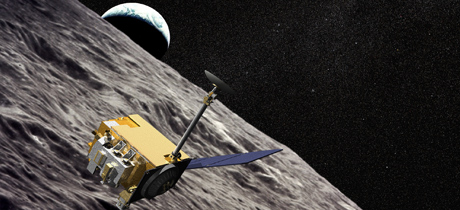In Today’s Deep Space Extra… The Lunar Reconnaissance Orbiter (LRO) is a key element for NASA, international partners and commercial industry at the Moon. A Russian spacewalk planned for Tuesday will look for signs of external damage to the International Space Station’s (ISS) Russian segment. NASA’s Voyager 2 has left the solar system, and the agency’s Osiris Rex spacecraft has detected water rich minerals at its sample return target, the asteroid Bennu.
Human Space Exploration
NASA lunar orbiter now supporting commercial and international missions
SpaceNews.com (12/10): Launched in 2009 as part of former president George W. Bush’s cancelled Constellation return to the moon initiative, NASA’s Lunar Reconnaissance Orbiter (LRO) continues to observe and map the Moon’s surface. LRO, is appears, has the fuel and staying power to support with imagery new commercial and international missions to the surface of the Moon to help establish a future sustained human presence.
Space Station crew to inspect mysterious hole on spacewalk
Associated Press via ABC News (12/11): Cosmonauts Oleg Kononenko and Sergey Prokopyev are to embark on a spacewalk Tuesday outside the International Space Station’s (ISS) Russian segment. They are to examine thermal and orbital debris shielding external to the source of an internal air leak detected in late August and patched. The cause of the internal air pressure loss remains under a Russian led investigation with NASA consultation.
Space Science
It’s official! NASA’s famed Voyager 2 spacecraft reaches interstellar space
Space.com (12/10): NASA science teams have confirmed that Voyager 2, a mission launched to the outer solar system in 1977, has now entered interstellar space. Voyager 1, also launched in 1977, made the same transition in 2012. Voyager 2 is the only spacecraft to have visited all four gas giant planets Jupiter, Saturn, Uranus and Neptune and discovered 16 moons. The plutonium powered probe is expected to continue its exploration until sometime after 2025.
That was fast: OSIRIS-REx probe detects water on asteroid Bennu during approach
Geekwire.com (12/10): A week after their Osiris Rex asteroid sample return spacecraft reached its destination, the near Earth object Bennu, mission scientists announced Monday at the American Geophysical Union meeting the spacecraft’s instruments have confirmed the presence of water in hydrated minerals in the carbon rich planetary body. Bennu is believed to have emerged from a long ago collision in the main asteroid belt that enriched it with materials largely unchanged since the early era of the solar system. Samples gathered from the surface and returned to Earth for study could reveal whether the merging of objects like Bennu formed rocky planets like Earth and provided the water and organics for life.
New Horizons course correction puts spacecraft on target to Ultima Thule
Spaceflightinsider.com (12/10): A December 2 course correction maneuver by NASA’s New Horizon’s spacecraft, while some 4 billion miles from Earth, placed the spacecraft on a course to fly within 2,200 miles of the Kuiper Belt Object Ultima Thule on January 1 at 12:33 a.m., EDT. New Horizons gained fame as it flew close to distant Pluto in July 2015.
You can beam a message to NASA’s New Horizons spacecraft for historic flyby!
Space.com (12/10): The New Horizons spacecraft, which passed close to Pluto in the most distant flyby of a planetary object ever in July 2015, is on course to pass close to a second Kuiper Belt Object, Ultima Thule, on New Year’s Day. Alan Stern, the New Horizons principal investigator, is inviting the public to send greetings by way of the Johns Hopkins Applied Physics Laboratory, which provides day to day mission management.
Other News
Congress and commerce in the final frontier (part 1)
The Space Review (12/10): Why has the growth and promise of commercial space accelerated especially in the U.S. An op-ed from Cody Knipfer examines the history of legislative incentives and infusions of new technology and private capital that seem to be behind the move.
For the small launch industry, just wait until next year
The Space Review (12/10): 2018, it turns out, has been another year of assessing and exploring a promising small satellite launch market, especially for hopeful startups. In many cases, plans to start orbital launches in 2018 are slipping a year, writes TSR editor Jeff Foust.
Astronauts set to host Apollo 8 and ‘Earthrise’ celebrations at Kennedy Space Center
Florida Today (12/7): A December 21 event at the Kennedy Space Center Visitor Complex (KSCVC) is to mark the 50th anniversary of NASA’s Apollo 8 launch, the first mission to usher human explorers beyond Earth orbit. Apollo 8 sent three NASA astronauts, Jim Lovell, Frank Borman and Bill Anders, around the Moon and back to Earth over Christmas in 1968. “Earthrise,” their startling photo of Earth, quickly became a symbol of the mission.

